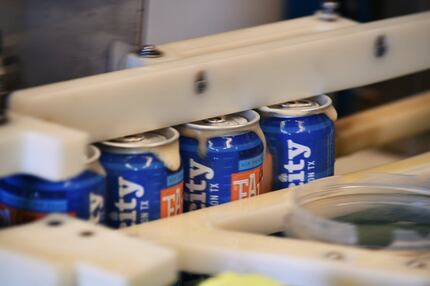In the early days of craft beer, getting liquid from tank to table meant packaging it in either a bottle or a keg. For most, cans weren't a consideration. That delivery method was the stereotypical domain of "big beer" — a phrase some equated to bad beer and a stigma strengthened by the belief that canned beer had a tendency to taste like tin.
However, with the addition of polymer liners, technology has taken care of the taste issue in modern-day cans. Assuming proper storage and handling once the product leaves the brewery, quality beer can now be found in all three formats.
But which format helps brewers put the freshest beer into consumers' hands?
Ask local brewers and you'll find that the answer isn't as clear-cut as you might expect.

Take keg beer, for instance. While some say kegs are best for beers served fresh, like light lagers and hop-forward styles, Michael Peticolas, founder of Peticolas Brewing Co. in Dallas, says the styles he intended to brew weren't part of the thought process in making his brewery a draft-only operation.
"When I started, the decision not to bottle or can rested primarily with quality as a whole," says Peticolas. "One of the reasons I haven't packaged my beer is because everyone else is doing it. When everyone else zigs, I like to zag. So, in that way, I'm doing something different that distinguishes us in the market."
Differentiation also played a role in 2013, when Martin House Brewing Co. became the first North Texas brewery to offer its beer in cans. Other key benefits influenced the brewery's packaging decision as well, like a can's ability to shut out light and oxygen, the ease of recycling and the fact that a lightweight can mean lower shipping costs.
Yet, in the end, a can's ability to go places that bottles can't is what tipped the scales, according to founder Cody Martin.
"All the known arguments played a part," says Martin, "but we like to consider ourselves an outdoorsy brand, so portability was probably the most crucial factor in the decision to go with cans."
As for choosing between bottles and cans, Community Beer Co. founder Kevin Carr has a unique perspective — his brewery is one of the few in North Texas offering beer both ways.
Using bottles is partly a desire to keep with tradition, Carr says, since breweries have been bottling beer for hundreds of years. Beyond that, Carr feels certain types of beers are a better fit in glass.
"Bottles are more suitable for a package-conditioned beer, as well as limited releases, particularly barrel-aged or seasonal high-ABV brews," he says. "And there seems to be a higher-level imagery when it comes to certain beers in bottles versus cans. Some special releases deserve a more sophisticated container, and bottles achieve that more than cans."
Still, it's hard to ignore the popularity of cans, especially when consumers have preferences of their own about how and where they drink their beer.
"What led us to start canning some of our beers was we thought it would be fun to do, and we felt our lower ABV beers were perfect for that format," says Carr. "Another factor was market demand. We had many fans request beer in cans, so they could be enjoyed by the pool, at the lake or while camping."
At the same time, Carr says he's seen data that suggests consumers are starting to gravitate back to bottles, but that doesn't mean Community is going to make any changes to its approach.
"Having bottles is actually starting to help brands stand out on the shelf since fewer breweries are still bottling," he says, "but we feel having Community brews available in both formats provides consumers with a wide range of choice."
By Brian Brown/Special Contributor

